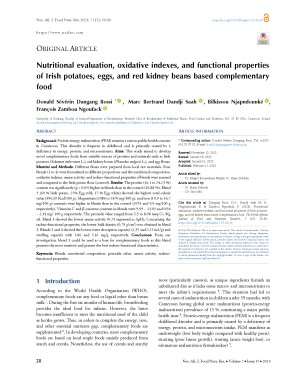Nutritional evaluation, oxidative indexes, and functional properties of Irish potatoes, eggs, and red kidney beans based complementary food
Abstract
Background: Protein-energy malnutrition (PEM) remains a serious public health concern in Cameroon. This disorder is frequent in childhood and is primarily caused by a deficiency in energy, protein, and micronutrients. Aims: This study aimed to develop novel complementary foods from suitable sources of proteins and minerals such as Irish potatoes (Solanum tuberosum L.), red kidney beans (Phaseolus vulgaris L.), and egg flours. Material and Methods: Different flours were prepared from local raw materials. Four blends (1 to 4) were formulated at different proportions and the nutritional composition, oxidative indexes, urease activity, and techno-functional properties of blends were assessed and compared to the Irish potato flour (control). Results: The protein (16.1 to 24.23 %) content was significantly (p < 0.05) higher in blends than in the control (10.88 %). Blend 3 (60 % Irish potato, 25% Egg yolk, 15 % Egg white) showed the highest total calorie value (396.69 Kcal/100 g). Magnesium (2084 to 2470 mg/100 g), and iron (10.9 to 14.7 mg/100 g) contents were higher in blends than in the control (2053 and 9.9 mg/100 g respectively). Vitamins C and β-carotene contents in blends were 9.99 – 13.03 and 0.94 – 2.34 mg/ 100 g respectively. The peroxide value ranged from 5.3 to 8.98 meq O2 /Kg oil. Blend 3 showed the lowest urease activity (0.73 expressed as ΔpH). Concerning the techno-functional properties, the lowest bulk density (0.79 g/cm3) was obtained in blend 3. Blends 3 and 4 showed the lowest water absorption capacity (2.35 and 2.25 mL/g) and swelling capacity with 5.86 and 5.16 mg/g respectively. Conclusions: From our investigation, blend 3 could be used as a base for complementary foods as this blend presents the most nutritive and present the best techno-functional characteristics.
Full text article
Authors
Copyright (c) 2023 Donald Sévérin Dangang Bossi, Marc Bertrand Dandji Saah, Bilkissou Njapndounké, François Zambou Ngoufack

This work is licensed under a Creative Commons Attribution 4.0 International License.
-
Attribution — You must give appropriate credit, provide a link to the license, and indicate if changes were made. You may do so in any reasonable manner, but not in any way that suggests the licensor endorses you or your use.
-
No additional restrictions — You may not apply legal terms or technological measures that legally restrict others from doing anything the license permits.





